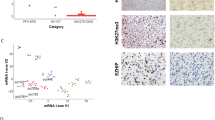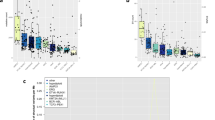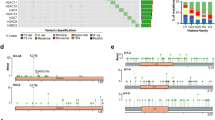Abstract
Glioblastoma multiforme (GBM) is a lethal brain tumour in adults and children. However, DNA copy number and gene expression signatures indicate differences between adult and paediatric cases1,2,3,4. To explore the genetic events underlying this distinction, we sequenced the exomes of 48 paediatric GBM samples. Somatic mutations in the H3.3-ATRX-DAXX chromatin remodelling pathway were identified in 44% of tumours (21/48). Recurrent mutations in H3F3A, which encodes the replication-independent histone 3 variant H3.3, were observed in 31% of tumours, and led to amino acid substitutions at two critical positions within the histone tail (K27M, G34R/G34V) involved in key regulatory post-translational modifications. Mutations in ATRX (α-thalassaemia/mental retardation syndrome X-linked)5 and DAXX (death-domain associated protein), encoding two subunits of a chromatin remodelling complex required for H3.3 incorporation at pericentric heterochromatin and telomeres6,7, were identified in 31% of samples overall, and in 100% of tumours harbouring a G34R or G34V H3.3 mutation. Somatic TP53 mutations were identified in 54% of all cases, and in 86% of samples with H3F3A and/or ATRX mutations. Screening of a large cohort of gliomas of various grades and histologies (n = 784) showed H3F3A mutations to be specific to GBM and highly prevalent in children and young adults. Furthermore, the presence of H3F3A/ATRX-DAXX/TP53 mutations was strongly associated with alternative lengthening of telomeres and specific gene expression profiles. This is, to our knowledge, the first report to highlight recurrent mutations in a regulatory histone in humans, and our data suggest that defects of the chromatin architecture underlie paediatric and young adult GBM pathogenesis.
This is a preview of subscription content, access via your institution
Access options
Subscribe to this journal
Receive 51 print issues and online access
$199.00 per year
only $3.90 per issue
Buy this article
- Purchase on Springer Link
- Instant access to full article PDF
Prices may be subject to local taxes which are calculated during checkout



Similar content being viewed by others
Accession codes
Data deposits
Sequence reads for GBM samples have been deposited in the European Genome Archive under accession number EGAS00001000226.
References
Faury, D. et al. Molecular profiling identifies prognostic subgroups of pediatric glioblastoma and shows increased YB-1 expression in tumors. J. Clin. Oncol. 25, 1196–1208 (2007)
Haque, T. et al. Gene expression profiling from formalin-fixed paraffin-embedded tumors of pediatric glioblastoma. Clin. Cancer Res. 13, 6284–6292 (2007)
Paugh, B. S. et al. Integrated molecular genetic profiling of pediatric high-grade gliomas reveals key differences with the adult disease. J. Clin. Oncol. 28, 3061–3068 (2010)
Qu, H. Q. et al. Genome-wide profiling using single-nucleotide polymorphism arrays identifies novel chromosomal imbalances in pediatric glioblastomas. Neuro-oncol. 12, 153–163 (2010)
Villard, L. et al. XNP mutation in a large family with Juberg-Marsidi syndrome. Nature Genet. 12, 359–360 (1996)
Dhayalan, A. et al. The ATRX-ADD domain binds to H3 tail peptides and reads the combined methylation state of K4 and K9. Hum. Mol. Genet. 20, 2195–2203 (2011)
Lewis, P. W., Elsaesser, S. J., Noh, K. M., Stadler, S. C. & Allis, C. D. Daxx is an H3.3-specific histone chaperone and cooperates with ATRX in replication-independent chromatin assembly at telomeres. Proc. Natl Acad. Sci. USA 107, 14075–14080 (2010)
Noushmehr, H. et al. Identification of a CpG island methylator phenotype that defines a distinct subgroup of glioma. Cancer Cell 17, 510–522 (2010)
Phillips, H. S. et al. Molecular subclasses of high-grade glioma predict prognosis, delineate a pattern of disease progression, and resemble stages in neurogenesis. Cancer Cell 9, 157–173 (2006)
The Cancer Genome Atlas Research Network. Comprehensive genomic characterization defines human glioblastoma genes and core pathways. Nature 455 1061–1068 (2008) Medline CrssRef
Parsons, D. W. et al. An integrated genomic analysis of human glioblastoma multiforme. Science 321, 1807–1812 (2008)
Bax, D. A. et al. A distinct spectrum of copy number aberrations in pediatric high-grade gliomas. Clin. Cancer Res. 16, 3368–3377 (2010)
Parsons, D. W. et al. The genetic landscape of the childhood cancer medulloblastoma. Science 331, 435–439 (2011)
Iwase, S. et al. ATRX ADD domain links an atypical histone methylation recognition mechanism to human mental-retardation syndrome. Nature Struct. Mol. Biol. 18, 769–776 (2011)
Goldberg, A. D. et al. Distinct factors control histone variant H3.3 localization at specific genomic regions. Cell 140, 678–691 (2010)
Wong, L. H. et al. ATRX interacts with H3.3 in maintaining telomere structural integrity in pluripotent embryonic stem cells. Genome Res. 20, 351–360 (2010)
De La Fuente, R., Viveiros, M. M., Wigglesworth, K. & Eppig, J. J. ATRX, a member of the SNF2 family of helicase/ATPases, is required for chromosome alignment and meiotic spindle organization in metaphase II stage mouse oocytes. Dev. Biol. 272, 1–14 (2004)
Verhaak, R. G. et al. Integrated genomic analysis identifies clinically relevant subtypes of glioblastoma characterized by abnormalities in PDGFRA, IDH1, EGFR, and NF1. Cancer Cell 17, 98–110 (2010)
Jiao, Y. et al. DAXX/ATRX, MEN1, and mTOR pathway genes are frequently altered in pancreatic neuroendocrine tumors. Science 331, 1199–1203 (2011)
Heaphy, C. M. et al. Altered telomeres in tumors with ATRX and DAXX mutations. Science 333, 425 (2011)
Chi, P., Allis, C. D. & Wang, G. G. Covalent histone modifications–miswritten, misinterpreted and mis-erased in human cancers. Nature Rev. Cancer 10, 457–469 (2010)
Füllgrabe, J., Kavanagh, E. & Joseph, B. Histone onco-modifications. Oncogene 30, 3391–3403 (2011)
Talbert, P. B. & Henikoff, S. Histone variants–ancient wrap artists of the epigenome. Nature Rev. Mol. Cell Biol. 11, 264–275 (2010)
Bernstein, B. E. et al. A bivalent chromatin structure marks key developmental genes in embryonic stem cells. Cell 125, 315–326 (2006)
Kolasinska-Zwierz, P. et al. Differential chromatin marking of introns and expressed exons by H3K36me3. Nature Genet. 41, 376–381 (2009)
Edmunds, J. W., Mahadevan, L. C. & Clayton, A. L. Dynamic histone H3 methylation during gene induction: HYPB/Setd2 mediates all H3K36 trimethylation. EMBO J. 27, 406–420 (2008)
Hakin-Smith, V. et al. Alternative lengthening of telomeres and survival in patients with glioblastoma multiforme. Lancet 361, 836–838 (2003)
Yan, H. et al. IDH1 and IDH2 mutations in gliomas. N. Engl. J. Med. 360, 765–773 (2009)
Dang, L. et al. Cancer-associated IDH1 mutations produce 2-hydroxyglutarate. Nature 462, 739–744 (2009)
Cervera, A. M., Bayley, J. P., Devilee, P. & McCreath, K. J. Inhibition of succinate dehydrogenase dysregulates histone modification in mammalian cells. Mol. Cancer 8, 89 (2009)
Li, H. & Durbin, R. Fast and accurate short read alignment with Burrows–Wheeler transform. Bioinformatics 25, 1754–1760 (2009)
Li, H. et al. The Sequence Alignment/Map format and SAMtools. Bioinformatics 25, 2078–2079 (2009)
Wang, K., Li, M. & Hakonarson, H. ANNOVAR: functional annotation of genetic variants from high-throughput sequencing data. Nucleic Acids Res. 38, e164 (2010)
Nakamura, K. et al. Sequence-specific error profile of Illumina sequences. Nucleic Acids Res. 39, e90 (2011)
Peiffer, D. A. et al. High-resolution genomic profiling of chromosomal aberrations using Infinium whole-genome genotyping. Genome Res. 16, 1136–1148 (2006)
Acknowledgements
The authors are indebted to J. Rak, N. Sonenberg and C. Polychronakos for critical reading of this manuscript. D. M. Pearson, A. Wittmann, L. Sieber and L. Senf are acknowledged for technical assistance. This work was supported by the Cole Foundation, and was funded in part by Genome Canada and the Canadian Institute for Health Research (CIHR) with co-funding from Genome BC, Genome Quebec, CIHR-ICR (Institute for Cancer Research) and C17, through the Genome Canada/CIHR joint ATID Competition (project title: The Canadian Paediatric Cancer Genome Consortium: Translating next generation sequencing technologies into improved therapies for high-risk childhood cancer (NJ)), the Hungarian Scientific Research Fund (OTKA) Contract No. T-04639, the National Research and Development Fund (NKFP) Contract No. 1A/002/2004 (P.H., M.G., L.B.), the PedBrain project contributing to the International Cancer Genome Consortium funded by the German Cancer Aid (109252) and the CNS tumour tissue bank within the priority program on tumour tissue banking of the German Cancer Aid (108456), the BMBF, the Samantha Dickson Brain Tumour Trust, a grant from the National Cancer Center Heidelberg (“Paediatric Brain Tumor Preclinical Testing”), and a guest scientist stipend to M.R. from the German Cancer Research Center. X.-Y.L. and A.M.F. are the recipients of studentship awards from CIHR. K.J. is the recipient of a studentship from the Foundation of Stars. S.M.P. is the recipient of the Sybille Assmus Award for Neurooncology in 2009 and N.J. is the recipient of a Chercheur Boursier Award from Fonds de Recherche en Santé du Québec.
Author information
Authors and Affiliations
Contributions
A.K., X.-Y.L., D.T.W.J., E.P., D.-A.K.Q., S.A., M.T., Z.D., P.S., N. Jäger, H.W., T.M., C.Z., U.T., P.C.-B., D.F., P.L. and A.M. performed experimental work. X.-Y.L., J.S., J.M., D.T.W.J., M.K., D.M., V.H., K.J., A.M.F., D.S., A.N., C.K., A.L., A.K., T.R., J.M., J.O.K., T.H., P.L., C.P., S.M.P. and N. Jabado performed data analyses and produced the text and figures. M.R., M.E., M.U.S., W.S., A.P. and M.C.F., W.R., C.K., M.D., J.A., P.H., M.G., L.B., P.P.L., M. Zakrzewska, K.Z., A.E.K., M. Zapatka, A.G., A.K., G.R., J.F., A.v.D., K.I., V.P.C. and O.W. collected data and provided patient materials. J.M., S.M.P. and N. Jabado provided leadership for the project. All authors contributed to the final manuscript.
Corresponding authors
Ethics declarations
Competing interests
The authors declare no competing financial interests.
Supplementary information
Supplementary Information
This file contains Supplementary Tables 1-9 and Supplementary Figures 1-7 with legends. (PDF 1439 kb)
Rights and permissions
About this article
Cite this article
Schwartzentruber, J., Korshunov, A., Liu, XY. et al. Driver mutations in histone H3.3 and chromatin remodelling genes in paediatric glioblastoma. Nature 482, 226–231 (2012). https://doi.org/10.1038/nature10833
Received:
Accepted:
Published:
Issue Date:
DOI: https://doi.org/10.1038/nature10833
This article is cited by
-
PDGFRA K385 mutants in myxoid glioneuronal tumors promote receptor dimerization and oncogenic signaling
Scientific Reports (2024)
-
PRMT5 inhibition shows in vitro efficacy against H3K27M-altered diffuse midline glioma, but does not extend survival in vivo
Scientific Reports (2024)
-
A new genomic framework to categorize pediatric acute myeloid leukemia
Nature Genetics (2024)
-
The evolutionary impact of childhood cancer on the human gene pool
Nature Communications (2024)
-
HIRA vs. DAXX: the two axes shaping the histone H3.3 landscape
Experimental & Molecular Medicine (2024)
Comments
By submitting a comment you agree to abide by our Terms and Community Guidelines. If you find something abusive or that does not comply with our terms or guidelines please flag it as inappropriate.



